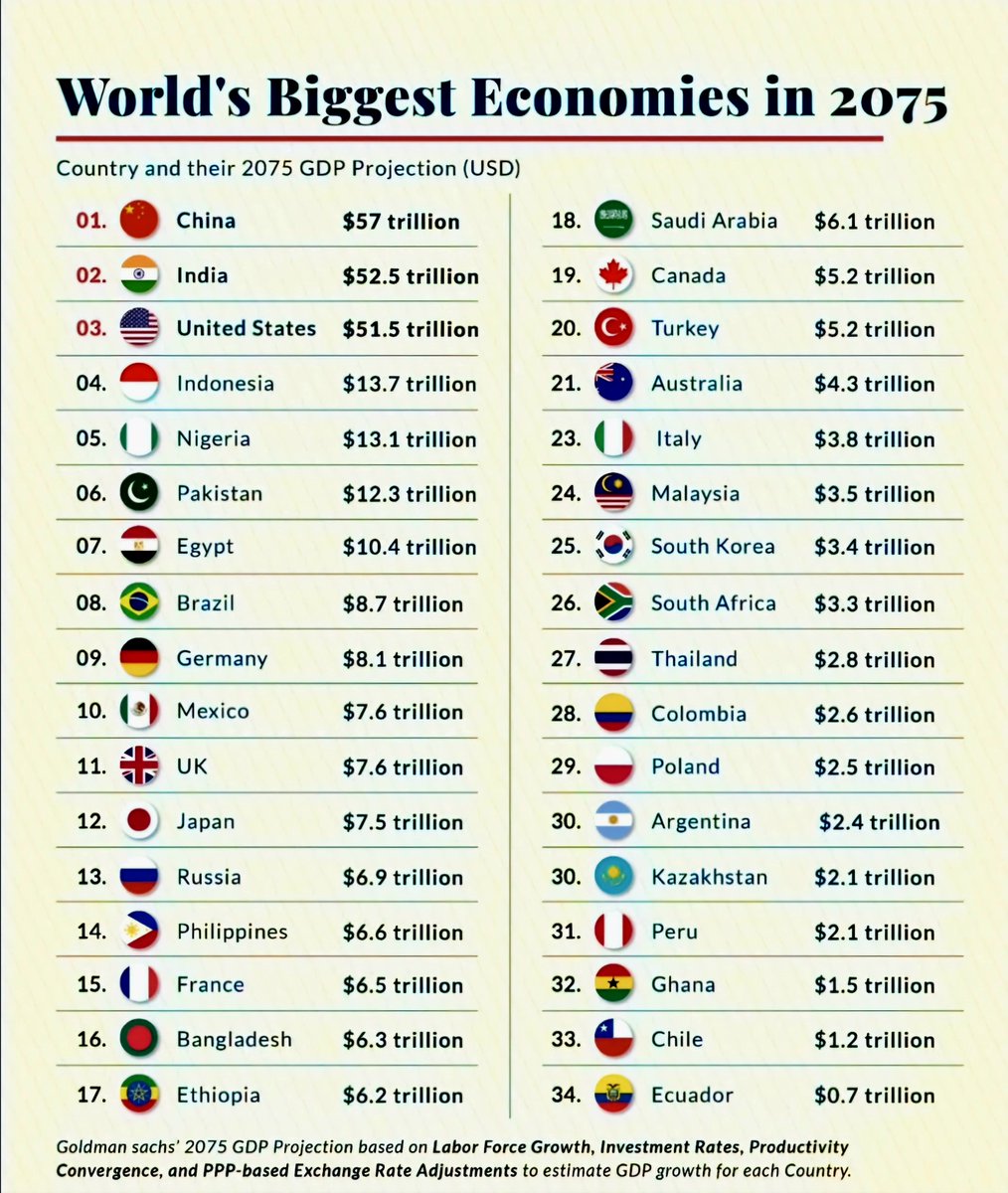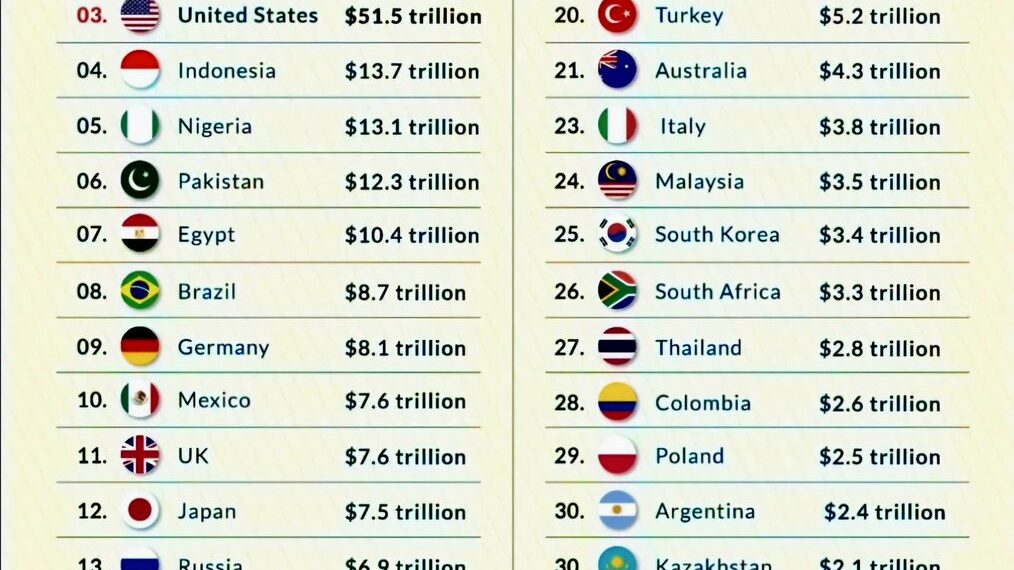Select Language:
The Future of Global Power: Top Economies by 2075

1. China: Dominating the Global Stage
By 2075, China is projected to solidify its position as the world’s largest economy. Over the past five decades, the nation’s strategic investments in technology, infrastructure, and education have paid off, propelling it ahead of traditional economic powerhouses. China’s focus on innovation, coupled with its expansive manufacturing sector and a large, increasingly skilled workforce, positions it uniquely for continued growth. The Belt and Road Initiative and advancements in artificial intelligence and green energy are expected to further enhance China’s economic dominance.
2. United States: Maintaining Cultural and Technological Leadership
Despite intense competition, the United States is anticipated to remain a top contender within the top three global economies. Its entrepreneurial spirit, robust technological innovation, and strong consumer market have contributed to past growth, and these qualities are projected to keep the U.S. in a leading position through 2075. Continued investments in space exploration, digital technology, and sustainable energy are expected to sustain its influence. Additionally, the U.S.’s ability to adapt to new economic trends, like automation and digital currencies, may give it an edge even as other nations catch up.
3. India: Rising with Demographics and Innovation
India’s economy is forecasted to grow exponentially over the next fifty years, driven by its youthful population, expanding middle class, and a rising emphasis on technological innovation. By 2075, India is expected to rival the size of the U.S. and China, thanks to a focus on infrastructure development, digital connectivity, and renewable energy initiatives. Its large labor force is anticipated to be a significant driver of growth, especially with ongoing reforms in education and technology sectors. India’s strategic geographic position and increasing foreign investments also play vital roles in this projection.
4. European Union: Adapting to a Changing World
While the European Union might not be the top economy, it is poised to maintain its influence through a unified economic approach and emphasis on sustainable growth. Countries within the EU are investing heavily in green technology, artificial intelligence, and digital infrastructure, positioning themselves as leaders in combating climate change and fostering innovation. The bloc’s ability to adapt politically and economically will determine its standing in the global hierarchy by 2075.
5. Nigeria and African Economies: Emerging Powerhouses
Africa’s potential economic rise is a key theme in future projections. Nigeria, with its rapidly growing population and resource-rich economy, is expected to become a significant global player by 2075. Increasing investments in technology, agriculture, and infrastructure are fueling this growth. Other African countries are also expected to emerge as major players, benefiting from advancements in connectivity, education, and economic diversification strategies. Africa’s youthful demographics and resource abundance are central to its projected rise.
6. Brazil and South America: Regional Leaders
South American countries like Brazil are projected to climb into the top economies by 2075, driven by agro-industrial exports, renewable energy, and technological innovation. Brazil’s vast natural resources and strategic investments in sustainable agriculture are expected to contribute significantly to its economic stature. Other South American nations might follow suit through regional integration and infrastructural improvements, making the continent more influential on the global economic stage.
7. Japan and South Korea: Continual Innovation
Asia’s technological powerhouses, Japan and South Korea, are predicted to sustain their influential global roles through continuous innovation. Japan’s advancements in robotics, healthcare, and green technology will help it evolve beyond traditional manufacturing. South Korea’s strength in semiconductors, electronics, and cutting-edge research will ensure it remains competitive. Both nations are expected to adapt to changing technological landscapes, maintaining their status as major economic players.
8. Indonesia: Southeast Asia’s Emerging Power
Indonesia is positioned to become Southeast Asia’s economic leader by 2075, owing to its large population, natural resources, and strategic location. Investment in infrastructure, digital technology, and renewable energy are key drivers behind its growth. With a focus on developing manufacturing and services sectors, Indonesia’s expanding middle class and urbanization will play crucial roles in elevating its global economic profile.
9. Canada: Stable Growth with Sustainable Goals
Canada’s economy is expected to thrive through a combination of natural resource management and innovation-driven industries. Its focus on sustainable development, clean energy, and technological innovation will help it sustain growth while maintaining environmental commitments. As a developed nation with strong institutions, Canada’s economy will likely remain influential and resilient in global rankings by 2075.
10. Mexico: Next-Gen Manufacturing Hub
Mexico’s strategic location and dynamic manufacturing sector are expected to propel it into the top tier of global economies. Investment in infrastructure, digital transformation, and renewable energy projects are fueling economic expansion. Its integration with North American markets and improvements in education and technology infrastructure position Mexico as a rising economic leader on the world stage.
In the years ahead, these nations will shape the future’s economic landscape, driven by innovation, resource management, and strategic investments. The shifting power dynamics highlight a more multipolar world, emphasizing collaboration and competition among the globe’s top economies.






